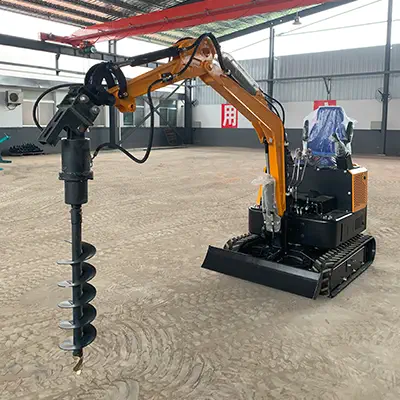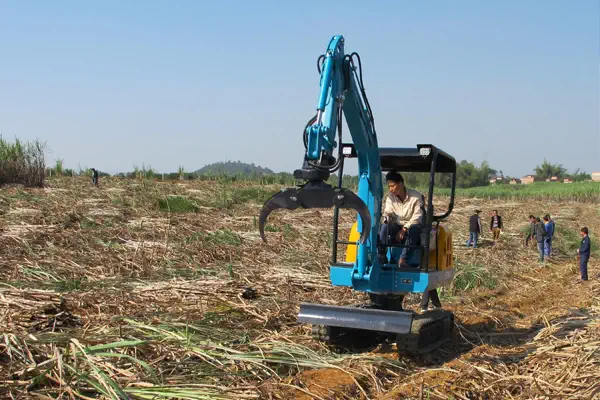
Mini excavator
We provide various types of Mini excavators. If you need customization, please feel free to contact us.
Know More About Mini excavator
Mini excavators, also known as compact excavators. They are versatile construction machines used for digging, lifting, and other material-handling tasks. Here are some of the common features and characteristics of mini excavators:
- Compact Size: Mini excavators are smaller and more maneuverable than their larger counterparts. Their compact size allows them to work in confined spaces and navigate through narrow openings.
- Rubber Tracks: Many mini excavators are equipped with rubber tracks rather than traditional steel tracks, which provide better traction and minimize damage to surfaces like pavement and lawns.
- Attachments: Mini excavators can be fitted with various attachments, such as buckets, augers, hydraulic breakers, thumbs, and grapples, making them versatile tools for different tasks.
- Hydraulic System: Mini excavators have a powerful hydraulic system that controls the boom, arm, and bucket movements. This system provides precise control and efficiency.
- Swing Boom: Some mini excavators have a swing boom, which allows the operator to work in a smaller footprint by rotating the upper structure without moving the tracks.
- Zero or Reduced Tail Swing: Mini excavators come in different tail swing configurations. Zero tail swing models are ideal for tight spaces, while reduced tail swing models offer a compromise between compact size and a larger working range.







Technical specs comparison of Mini excavator
| Specification | Unit | LZ08 | LZ10 | LZ16 | LZ17 | LZ20 |
| Machine weight | kg | 800 | 1000 | 1200 | 1500 | 1800 |
| Bucket capacity | m³ | 0.02 | 0.02 | 0.03 | 0.04 | 0.045 |
| Bucket width | mm | 300 | 400 | 400 | 400 | 400 |
| Digging depth | mm | 1200 | 1500 | 1800 | 1900 | 2150 |
| Engine | / | Koop | Koop | Laidong | Laidong | Changchai |
| Engine power | hp | 12 | 12 | 26 | 39 | 29 |
Mini excavator application area

Construction
- Small body: The compact design of Mini excavators makes them suitable for operation in confined spaces, such as urban construction sites or interior renovation projects. They can easily traverse narrow passages and work in crowded areas.
- Mobility: These mini excavators have excellent maneuverability and can move around the job site and quickly adapt to different tasks. They often have the ability to rotate 360 degrees to perform multiple tasks in one position.
- Versatility: Mini excavators can use a variety of attachments such as buckets, drills, trenchers, clamps, etc. to meet different construction needs. This makes them very versatile and can perform tasks such as digging, cleaning, grabbing and lifting.
Landscaping
- Versatility: Mini excavators can be used with a variety of attachments, such as buckets, hoes, root saws and trenchers, to meet different landscaping needs. They can be used for clearing ground, digging trenches, planting trees, building creeks, and other tasks.
- Soil treatment: These small machines can help prepare soil, improve drainage, move soil, fill in low spots and create flower beds to support plant growth.
- Tree and Shrub Transplanting: Mini excavators can easily dig up trees and shrubs to transplant to new locations without damaging the root system.
- Cleanup and Drainage: Mini excavators improve the beauty and functionality of your landscape by clearing away debris, establishing drainage systems, and repairing sloughs.


Agriculture
- Soil improvement and land leveling: Mini excavators can be used for trench digging, trench filling, land preparation, land leveling, etc. to improve soil permeability and fertility and provide a good environment for the growth of crops.
- Facility agriculture: Mini excavators can be used to build greenhouses, greenhouses, fish ponds and other facility agriculture to improve the efficiency of agricultural production.
- Crop cultivation: Mini excavators can be used to dig planting holes, plant seedlings, transplant crops, etc., to improve crop planting efficiency.
- Agricultural waste treatment: Mini excavators can be used to clean up weeds, straw and other waste in farmland and improve the agricultural ecological environment.
Utility Work
- Compact Size: Mini excavators are well-suited for utility work in tight spaces and urban areas where larger equipment may not fit. They can work in confined areas, such as between buildings and along roadways.
- Maneuverability: Mini excavators are highly maneuverable, making it easier to navigate around obstacles, including utility poles, trees, and existing infrastructure.
- Precision Digging: Their precise control and ability to access confined areas make mini excavators ideal for digging trenches for utility lines, ensuring accuracy and minimizing the risk of damaging existing utilities.
- Versatile Attachments: Mini excavators can be fitted with a range of attachments, such as trenching buckets, augers, and hydraulic breakers, allowing them to perform various tasks required in utility work.


Soil improvement
- Digging Holes and Planting Trees: Mini excavators can easily dig deep, wide, and accurate holes for planting trees, shrubs, and other plants. This ensures that the plant has a good growing environment and that its roots are able to take root and get enough space.
- Soil Improvement: It can be used to mix, stir and improve soil to improve soil texture and fertility. This is great for soil improvement in gardening and agricultural projects.
- Irrigation system installation: A small excavator can be used to dig ditches and bury water pipes for irrigation systems to ensure that plants receive sufficient water.
Mini excavator Purchase Guide
When purchasing a mini excavator, it’s essential to consider various factors to ensure that you choose the right machine for your specific needs. Here’s a purchase guide to help you make an informed decision:
- Define Your Needs: Identify the specific tasks and applications for which you will use the mini excavator. Consider factors such as the type of work, size of the job site, and terrain.
- Machine Size and Weight Class: Determine the size and weight class of the mini excavator that best suits your requirements. Mini excavators typically range from 1 to 10 metric tons.
- Attachments: Consider the types of attachments you may need for your projects, such as buckets, hydraulic breakers, augers, or thumbs. Ensure that the mini excavator you choose is compatible with these attachments.
- Fuel Type: Decide on the fuel type based on your work environment. Options include diesel, electric, or hybrid models.
- Rubber Tracks or Steel Tracks: Choose between rubber tracks or steel tracks, depending on your work surface. Rubber tracks are suitable for minimizing ground damage, while steel tracks offer durability.
- Cab or Open Canopy: Decide whether you want a cab or an open canopy. A cab provides better operator comfort in adverse weather conditions, while an open canopy is suitable for good weather.
- Tail Swing Configuration: Determine your preference for tail swing configuration. Options include zero tail swing, minimal tail swing, and conventional tail swing, each offering different advantages in terms of maneuverability and workspace.
- Brand and Dealer Reputation: Research reputable mini excavator brands and dealers known for quality machines, reliable service, and readily available spare parts.
- Operator Comfort and Safety: Ensure that the mini excavator is equipped with features for operator comfort and safety, such as an adjustable seat, climate control, ROPS, FOPS, and backup cameras.
- Hydraulic System: Check the machine's hydraulic system for its performance and the number of hydraulic lines for attachments. A powerful hydraulic system is essential for efficient operation.
- Maintenance Requirements: Inquire about the maintenance and service requirements of the machine, including ease of access for routine maintenance.
- Warranty: Review the manufacturer's warranty to understand what is covered and the duration of coverage.
If you have questions when purchasing a Mini excavator or would like to learn more about the performance of our Mini excavator equipment,
please click the button below to contact us.
FAQ About Mini excavator
A mini excavator, also known as a compact excavator, is a small, versatile construction machine used for digging, lifting, and other material-handling tasks. It typically weighs between 1 to 10 metric tons.
Mini excavators are commonly used for tasks such as digging trenches, excavating foundations, landscaping, demolition, and utility work, including digging and backfilling trenches for pipelines and cables.
Mini excavators work by using hydraulic systems to control the movement of the boom, arm, and bucket. Operators use joystick controls to manipulate these components, allowing for precise digging and material handling.
Zero tail swing mini excavators have minimal rear overhang, making them ideal for working in tight spaces with limited clearance. Conventional tail swing excavators have a larger rear overhang and require more workspace.
Mini excavators can be equipped with a variety of attachments, including buckets, augers, hydraulic breakers, thumbs, grapples, and more. These attachments allow them to perform different tasks.
Yes, mini excavators can be used in various weather conditions, but some models are better equipped for extreme weather, with features like climate-controlled cabs and special attachments for snow removal.
The lifespan of a mini excavator can vary depending on factors like maintenance and usage. With proper care, they can last 10,000 hours or more, which can translate to many years of use.
Regular maintenance includes checking fluid levels, inspecting tracks or tires, changing filters, and scheduling routine service as recommended by the manufacturer.
Have Anything To Ask Us?
Please fill in your email in the form and we’ll get back to assist you soon!
- Will contact you within 1 hour.
- Don't worry, we hate spam too!









